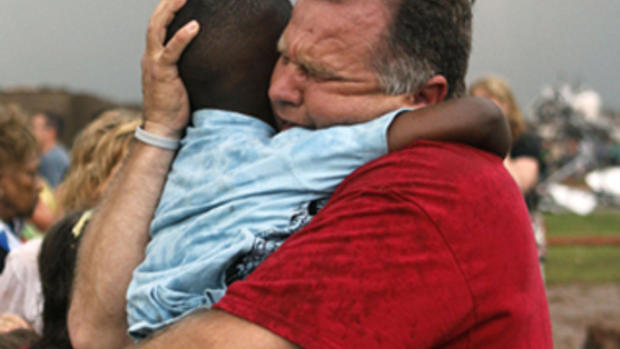Oklahoma tornado aftermath filled with risks for victims, rescue workers
Rescue efforts continued early Tuesday in the Oklahoma City area after a half-mile wide tornado ripped through the region Monday, killing at least 24 people and potentially injuring hundreds more.
In the first 24 hours after of a disaster like a tornado, there are several challenges and health risks facing both rescue workers and victims, explained Dr. Matthew Levy, an assistant professor of emergency medicine at Johns Hopkins Medicine in Baltimore, in an interview with CBSNews.com.
Levy has no direct involvement with the ongoing rescue efforts in Oklahoma, but has worked in disaster response beginning in 1992 as an EMT. He's currently the founding commander of the Maryland Disaster Medical Assistance Team.
Levy said immediate concerns turn to extricating survivors from the rubble, because they may have lacerations and crush injuries from being pinned under structures. A crush injury to the arms and legs in time can lead to crush syndrome, a condition in which the pressure from the injury triggers the muscles to release toxic muscle components and electrolytes that can disrupt organ function and shut down the kidneys.
What's unique about these types of injuries, said Levy, is that because a person is pinned, they also face significant secondary health risks of exposure, dehydration, hypothermia and shock.
Risk of succumbing to these injuries increases as time goes on, Levy points out, which adds to the urgency. But, rescue crews are often equipped with a medical provider who has the ability to perform a field emergency procedure, be it providing IV fluids, pain medicines, supporting for the victim's breathing or performing an amputation if necessary for the rescue.
Other types of injuries facing victims include eye injuries from falling debris, puncture wounds that may be contaminated with soil or sand (thus raising infection risk), and tetanus, a serious infection that can lead to muscle spasms of the jaw and spine, Dr. Robert Glatter, an emergency medicine physician at Lenox Hill Hospital in New York City, added to CBSNews.com in an email. In cases where immunization status is unclear, a vaccine may be provided.
Exposure to carbon monoxide gas may also be a risk for some people trapped by debris, said Glatter.
The fact that children are among the potential victims -- two elementary schools were hit by the tornado -- presents other unique challenges for rescuers, said Levy. Toddlers and young children under 4 or 5 years old may have heads disproportionately larger than their bodies, making them more susceptible to head injuries. He added that young children tend to not be able to regulate their own body temperatures as well as adults, and could face hypothermia if left out in the elements for prolonged periods. Generally speaking, according to Levy, children have a high threshold to withstand trauma, and he points out children have been shown to compensate for a short period of time when they are critically injured. However, after this period, their bodies decompensate rapidly, not leaving much time for rescue workers.
The rescue workers themselves also face injury risks as they attempt to find survivors. They are often walking or standing on unsteady ground and piles of shifting debris, and may fall through -- something Levy saw firsthand when responding to Hurricane Katrina.
The debris may also obscure other hidden risks like shards of glass and metal and gas and electrical lines, which can pose explosion or electrocution risks.
Since disaster rescue response often begins with local authorities before regional reinforcements arrive, Levy points out that these responders likely live in the affected areas, or may have children at affected schools. That can contribute to risks to their emotional well-being.
"Anytime children are involved, the emotional stakes are high," he said.
Glatter said that post-traumatic stress disorder, or PTSD, can be devastating to both adults and children after a disaster like a tornado.
Children will be less likely to experience prolonged fear and anxiety if they know what to expect after a tornado, according to the Centers for Disease Control and Prevention. Tips on how to talk to your children include talking about your own personal experiences with severe storms or reading aloud a book on tornadoes, listening carefully while showing understanding and including your child in clean-up activities. The CDC said a child may be comforted by having a job to do and watching the household begin to return to normal.
Further counseling may be required for those who have survived such an event, said Glatter.
When the dust has settled, other potential health risks arise in the cleanup efforts. About 50 percent of tornado-related injuries occur following the weather event, the CDC estimates.
Common injuries include stepping on nails, electrocution from damaged power lines, being hit by falling or rolling objects, and lacerations and open wounds.
This secondary spike in injuries often occurs within 72 hours of a disaster or after, according to Levy, as people try to salvage their personal belongings.
The CDC recommends people take safety precautions in the aftermath of a tornado:
- Be careful when entering any structure that's been damaged.
- Wear sturdy shoes or boots, long sleeves and gloves when handling debris.
- Look out for exposed nails and broken glass.
- Do not touch downed power lines or objects in contact with downed lines.
- Use battery-powered lanterns, if possible, rather than candles to light homes without electrical power. If you use candles, make sure they are in safe holders away from curtains, paper, wood, or other flammable items.
- Never use generators, pressure washers, grills, camp stoves or other gasoline, propane, natural gas or charcoal-burning devices inside your home, basement, garage, or camper--or even outside near an open window, door, or vent. Carbon monoxide (CO) -- an odorless, colorless gas that can cause sudden illness and death if you breathe it -- from these sources can build up in your home, garage, or camper and poison the people and animals inside.

